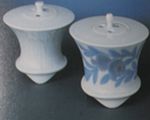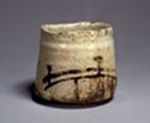The Desolation of Nihility: Aesthetic Analysis of Japanese Domestic Ceramics from the Perspective of Japanese Zen Culture
←
→
Page content transcription
If your browser does not render page correctly, please read the page content below
E3S Web of Conferences 179, 02095 (2020) https://doi.org/10.1051/e3sconf/202017902095
EWRE 2020
The Desolation of Nihility: Aesthetic Analysis of Japanese
Domestic Ceramics from the Perspective of Japanese Zen
Culture
Anfei Jiang1*, Jinbo Sun1
1University of Sanya, Sanya, Hainan, 572000, Chinaountry
Abstract. The culture of Zen comes into two diverse paths in China and Japan. Compared to China, the
Japanese Zen culture has characteristics of natural, plain, sensitive, vanity and silence. It is unrestrained
with feeble and desolation. And these characteristics are presented in Japanese domestic ceramic in the
unique beauty of its domestic ceramic.
leisure and quiet. Seen from the inside, there are
fundamental differences between the two countries. The
1 Introduction Zen culture in Japan has evolved into a rule system
The so-called Zen culture has two levels of meanings: without monastic rules and precepts for Buddhists. In
the first level includes the general term for the thoughts, artworks of Japanese Zen culture, true nature and
living habits, and lifestyles formed by the school of Zen, profound emotions with nihility can be identified, while
such as the jungle system. The second level refers to the slightly feeling of decadent sorrow, nihility, and desolate
general name of various literature, art, and customs under beauty characteristics.
the influence of Zen thoughts, such as Zen poems, Zen
paintings, and Zen tea. 3 The beauty of Zen culture in
Japanese domestic ceramic design
2 Zen culture in Japan
Domestic ceramics refer to ceramic products that are
On the surface, Japanese Zen and Chinese Zen seem to used in daily life, such as cups, dishes, dishes, bowls, etc.
be just as happy to be natural, peaceful, casual and empty, Come up from manufacturing methods, domestic
but there is a fundamental difference: Japanese Zen does ceramics can be divided into two kinds: handmade and
not keep precepts. The factors leading to this mechanized production.
characteristic are mainly derived from the Japanese Because of the lack of discipline in Japanese Zen
"object sorrow" aesthetic culture and bushido culture. culture, Japanese Zen is more secular than Chinese Zen.
Sorrow is a special term of Japanese aesthetic culture, Zen culture in Japan is more integrated into practical art.
that is, sorrow for things. Subconscious in Japanese don't In the field of domestic ceramic design in Japan,
believe in eternity. They feel the world with a influences from Japanese Zen culture can easily be
melancholy and sensitive heart. Aesthetic psychology of identified.
sorrow in Japanese people makes them accept the
vagaries of Zen quickly. In Japanese culture, precepts 3.1 The beauty of freedom and natural
can be ignored because they don't believe in eternity.
They are not willing to, or impossible to, focus more on The so-called "spontaneous nature" means the material,
mining deep steady foundation of Zen Culture. shape, and decoration of crafts can embody the Zen
In addition, the practice of Zen Culture has many culture vision of " one flower opens five leaves and the
kinds of resonates with Bushido. But the Zen meditation fruit grows naturally". Their aesthetic achievements are
of the Samurais has the characteristics of secular, unintentional and natural. The so-called "pamāda" means,
realistic, spiritual freedom and achieve the ultimate goals in the process of creation, improvisation and
of life directly in Zen culture. Because the samurai class entertainment are strong and informal, and the process
could not abstain from killing and drinking alcohol, the reflects the secular side of human nature. This kind of
Zen Culture gradually lost the requirement of work appears to have lasting appeal, sometimes appears
maintaining the precepts when it came to Japan. to be crude insipid.
To sum up, seen from the outside, Japanese Zen As shown in Figure 1, the materials of these plates
culture and Chinese Zen culture advocate simplicity, are rough and natural clay, which is randomly formed by
*Corresponding author’s e-mail: 363299067@qq.com
© The Authors, published by EDP Sciences. This is an open access article distributed under the terms of the Creative Commons Attribution
License 4.0 (http://creativecommons.org/licenses/by/4.0/).E3S Web of Conferences 179, 02095 (2020) https://doi.org/10.1051/e3sconf/202017902095
EWRE 2020
blank forming or clay board forming in the production used as gender spray or paint, with no bone the spring,
process. In the drying process, artists used no extra blank just like dance or flower. Artists’ painting skills and
repairing for the body and tried to maintain its natural layout arrangements show the vitality and vigorous
molding state. The decoration of these vessels are simple, nature with unique individual character. From their
rust flowers, just like a natural glaze. The composition of works, the charm of natural creation can be found with
their decoration is concise and aplomb, produced by a the feeling of the artist's romantic, dramatic character.
calligraphy pen, color glaze painters. The color glaze is
Figure 1. Color Glaze Plates.
The special aesthetic psychology of the "sorrow" of the
Japanese nation, is always a kind of dull and indifferent
3.2 The beauty of simplicity and simplicity
sorrow for things and objects. Therefore, Japanese
The so-called " essence of plain and simple " means, the ceramic works reflect the aesthetic culture of both
decoration and modeling of pottery and porcelain works simplicity and dryness.
are not luxuriant and delicate, while with the feeling of As shown in Figure 2 and Figure 3, Shino Tea Bowl’s
guilelessness and freedom out of the living world. From style presents a "the most delicate Zhuo" meaning, no
the perspective of Zen culture, these art creations are matter from the shape or decoration. The "coarse" in
accord with the perspective of "no mind, no appearance, their modeling, decoration and is concise and indifferent.
no residence", to achieve a Zen-style of "purification" The smell the breath of deadwood in the field and the
and natural effect. With the perspective of "no writing", faint earth fragrance in the mountain village can be
it sweeps away the vanity of the artificial world and identified...
restores the authenticity of the nature of heaven and earth.
Figure 2. Shino Tea Bowl (Sample 1) Figure 3. Shino Tea Bowl (Sample 2).
The artist applied a pure thick feldspar glaze to its
slightly rough soil, which was burnt as white as snow,
3.3 The beauty of pure, sentimental and
with flakes and speckled honeycombs. The bottom foot
delicate
and the contracted glaze reveal the red color of the kiln.
A few simple and clean strokes on the body painting The so-called "innocent love " in Zen culture means,
leave enough space and consciousness of painting, with through the observation of "self", the soul is washed into
the simple idea of Zen. Tacitus tea charm is expressed the pure true nature. The so-called "pure heart" in Zen
through simple shape and decoration to convey a dry and culture is filled with sincere pity for everything in the
indifferent. world. In Chinese Zen, due to the commandments, the
feeling of pity is accord with "no image outside, no heart
inside". The Japanese nation of sensitivity has a cherry
2E3S Web of Conferences 179, 02095 (2020) https://doi.org/10.1051/e3sconf/202017902095
EWRE 2020
blossom slender weak character. The sentimental mechanism product is full of gentle human touch. The
characteristic comes naturally in their ceramic works. color collaboration is white and sky blue to create a kind
As shown in Figure 4, the combination of tableware of pure and pure atmosphere.
is different from the general mechanism of domestic As shown in Figure 5, the fragrant fume jar also has
ceramics. The style of this set of tableware is not a single been decorated with the color combination of pure blue
repetition of the rigid shape. With a variety of and cyan. The waist shape of the jar shrinks slightly
combinations of curves of different ranges and lengths, inside in a soft and round way. The inverted triangle
the style of the tableware has been formed a rich visual bottom foot is delicate and cabinet, just like a young slim
effect. Because of the softness of the curve, this set of graceful girl.
Figure 4. Tableware set Figure 5. Fragrant fume jar.
As shown in Figure 4, the modeling of the tableware aesthetic "Sorrow" combined to form a "pursuit of
set goes up many curves and downy ribbon, and their incomplete and consciousness beauty. In fact, this
asymmetrical combination shows the psychology of the phenomenon reflects the Japanese nation’s core
thin line and dots on decoration. They are reflected in aesthetics of potential frustrated, powerless, nihilistic
Japanese sensitive and delicate aesthetics. The modeling heart, things and things of the pessimistic mood.
of Figure 5 of the jars is the inverted triangle form of the As shown in Figure 6, the ordinary ceramic vessel
big bottom, and their tapering bottom feet resemble a has broken gaps and cracks on its mouth and body. Their
touch of a combination of hazy and downy adornment simple, monotonous shape and color almost make people
effect, filling worn delicate and weak temperament. feel that this is a broken and randomly placed defective
work. However, the Zen culture of Japanese ceramic art
is embodied in pursuit of the imperfection and
3.4 The beauty of emptiness and desolation
incomplete to the object beauty. Infinity can be seen in
The nihility in Zen culture is based on the impermanence nihility and eternity and can be experienced in silence. Its
of the world. The Loneliness in Zen culture is based on drab modeling, color, and luster can make a person
the destination of annihilation. The Idle in Zen culture is experience a kind of leisurely and complacent, without
based on liability. The gentle in Zen culture is based on false decorate and life restrain. The beauty emphasizes a
liberation. In the Vajracchedika-sutra, the election of "all kind of implicitness inside collect. The broken places
can be accomplished, such as dream, dew, lightning, make people feel the impermanence and fragility of life.
should do as buddha." It refers to the theory of At the same time, a feeling of self-reflection and treasure
impermanence. In Zen Buddhism, through the has raised in the appreciation of beauty. It makes
observation of impermanence, one enters the realm of people's pain to get relief from sadness, finally into a
"all things are nihility, all troubles are silent". This leisurely and a state of indifferent beauty.
understanding of Zen and the traditional Japanese
Figure 6. Color Glaze Plates.
3E3S Web of Conferences 179, 02095 (2020) https://doi.org/10.1051/e3sconf/202017902095
EWRE 2020
4 Conclusion
Japan's domestic ceramic design fully embodies the
nation connotation of the cultural and spiritual,
presenting its unique beauty. With the awareness of fully
understanding and exploring their own cultural
characteristics, great works are worthy of research and
learn. To create great design works, the designer needs to
Emphasize national characteristics, absorb the excellent
results of other countries, avoid blindly copy. Only in
this way can we have a breakthrough design concept and
excellent design works.
Acknowledgments
This work was supported by Higher Education
Educational Reform Research Funding Project of
Hainan Provincial (Project No. Hnjg2018-68) and
University of Sanya Fist Class Undergraduate
Courses construction Project (Project No.
syxyylbkkc02-06).
References
1. N Zheng. (2001) Japanese Pottery. Heirongjiang Art
Publishing House, Haerbin.
2. W. Ye. (2003) History of Japanese Culture. Guangxi
Normal University Press, Nanning.
3. M. Yanagi. (2006) Craft Cultuer. GuangXi Normal
University Press, Guilin:
4. S. Wang. (2006) Modern Design History of World.
China Youth Press, Peking.
5. A. Li. (2003) Ceramic Design. China Academy of
Art Press, Hangzhou.
6. J. Shen. (2017) Research on Domestic Ceramic
Design Based on Youth Consumers' Aesthetic Needs.
China Ceramics, 53(09):88-92.
4You can also read
























































